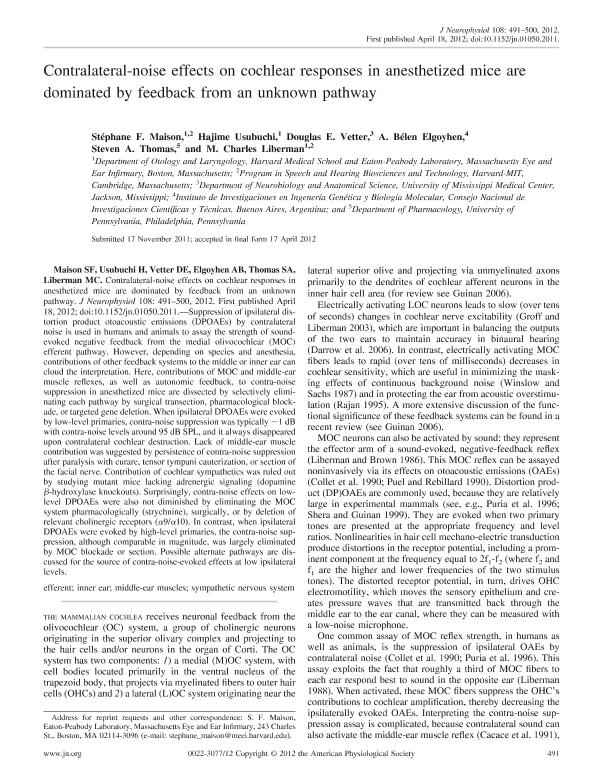Mostrar el registro sencillo del ítem
dc.contributor.author
Maison, Stéphane F.
dc.contributor.author
Usubuchi, Hajime
dc.contributor.author
Vetter, Douglas E.
dc.contributor.author
Elgoyhen, Ana Belen

dc.contributor.author
Thomas, Steven A.
dc.contributor.author
Charles Liberman, M.
dc.date.available
2019-07-15T20:26:28Z
dc.date.issued
2012-07
dc.identifier.citation
Maison, Stéphane F.; Usubuchi, Hajime; Vetter, Douglas E.; Elgoyhen, Ana Belen; Thomas, Steven A.; et al.; Contralateral-noise effects on cochlear responses in anesthetized mice are dominated by feedback from an unknown pathway; American Physiological Society; Journal of Neurophysiology; 108; 2; 7-2012; 491-500
dc.identifier.issn
0022-3077
dc.identifier.uri
http://hdl.handle.net/11336/79579
dc.description.abstract
Suppression of ipsilateral distortion product otoacoustic emissions (DPOAEs) by contralateral noise is used in humans and animals to assay the strength of soundevoked negative feedback from the medial olivocochlear (MOC) efferent pathway. However, depending on species and anesthesia, contributions of other feedback systems to the middle or inner ear can cloud the interpretation. Here, contributions of MOC and middle-ear muscle reflexes, as well as autonomic feedback, to contra-noise suppression in anesthetized mice are dissected by selectively eliminating each pathway by surgical transection, pharmacological blockade, or targeted gene deletion. When ipsilateral DPOAEs were evoked by low-level primaries, contra-noise suppression was typically ~1 dB with contra-noise levels around 95 dB SPL, and it always disappeared upon contralateral cochlear destruction. Lack of middle-ear muscle contribution was suggested by persistence of contra-noise suppression after paralysis with curare, tensor tympani cauterization, or section of the facial nerve. Contribution of cochlear sympathetics was ruled out by studying mutant mice lacking adrenergic signaling (dopamine β-hydroxylase knockouts). Surprisingly, contra-noise effects on lowlevel DPOAEs were also not diminished by eliminating the MOC system pharmacologically (strychnine), surgically, or by deletion of relevant cholinergic receptors (α9/α10). In contrast, when ipsilateral DPOAEs were evoked by high-level primaries, the contra-noise suppression, although comparable in magnitude, was largely eliminated by MOC blockade or section. Possible alternate pathways are discussed for the source of contra-noise-evoked effects at low ipsilateral levels. © 2012 the American Physiological Society.
dc.format
application/pdf
dc.language.iso
eng
dc.publisher
American Physiological Society

dc.rights
info:eu-repo/semantics/openAccess
dc.rights.uri
https://creativecommons.org/licenses/by-nc-sa/2.5/ar/
dc.subject
Efferent
dc.subject
Inner Ear
dc.subject
Middle-Ear Muscles
dc.subject
Sympathetic Nervous System
dc.subject.classification
Neurociencias

dc.subject.classification
Medicina Básica

dc.subject.classification
CIENCIAS MÉDICAS Y DE LA SALUD

dc.title
Contralateral-noise effects on cochlear responses in anesthetized mice are dominated by feedback from an unknown pathway
dc.type
info:eu-repo/semantics/article
dc.type
info:ar-repo/semantics/artículo
dc.type
info:eu-repo/semantics/publishedVersion
dc.date.updated
2019-07-10T13:39:56Z
dc.journal.volume
108
dc.journal.number
2
dc.journal.pagination
491-500
dc.journal.pais
Estados Unidos

dc.journal.ciudad
Bethesda
dc.description.fil
Fil: Maison, Stéphane F.. Massachusetts Eye and Ear Infirmary; Estados Unidos. Harvard University; Estados Unidos. Massachusetts Institute of Technology; Estados Unidos
dc.description.fil
Fil: Usubuchi, Hajime. Massachusetts Eye and Ear Infirmary; Estados Unidos
dc.description.fil
Fil: Vetter, Douglas E.. University of Mississippi; Estados Unidos
dc.description.fil
Fil: Elgoyhen, Ana Belen. Consejo Nacional de Investigaciones Científicas y Técnicas. Instituto de Investigaciones en Ingeniería Genética y Biología Molecular "Dr. Héctor N. Torres"; Argentina
dc.description.fil
Fil: Thomas, Steven A.. University of Pennsylvania; Estados Unidos
dc.description.fil
Fil: Charles Liberman, M.. Massachusetts Eye and Ear Infirmary; Estados Unidos. Harvard University; Estados Unidos. Massachusetts Institute of Technology; Estados Unidos
dc.journal.title
Journal of Neurophysiology

dc.relation.alternativeid
info:eu-repo/semantics/altIdentifier/url/https://www.physiology.org/doi/full/10.1152/jn.01050.2011
dc.relation.alternativeid
info:eu-repo/semantics/altIdentifier/doi/https://doi.org/10.1152/jn.01050.2011
Archivos asociados
